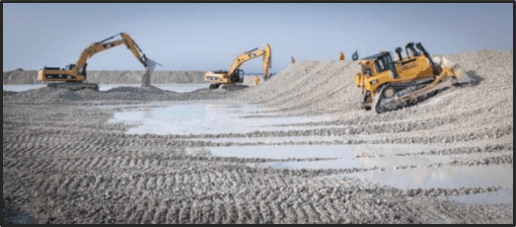Salt Harvesting
In the southern part of the Dead Sea, about 20 million tonnes of salt precipitate each year and create a layer of approximately 20 centimeters on the bottom of Pond 5, that is used by ICL Dead Sea for production. This production process requires maintaining a fixed volume of solutions (brines) in Pond 5. Therefore, the level of the solutions in the pond is raised each year according to the rate at which the pool floor rises. However, raising the water level of the pond above a certain level may cause structural damage to the foundations of the hotel structures situated close to the water’s edge and to other infrastructures on the western shoreline of Pond 5. The agreed solution - harvesting the salt. \
The minerals from the Dead Sea are extracted by way of solar evaporation, whereby salt precipitates onto the bed of one of the evaporation ponds at Sdom (Pond 5). The salt pond known as Pond 5 is the largest pond in the series of ponds, having an area of approximately 80 square kilometers. The evaporation processes give rise to concentration of the brines and the sinking of the salt to the floor of the pond. The remaining brines are rich in potash, magnesium and bromide. The precipitated salt creates a layer on the Pond bed of approximately 20 million tonnes annually. The process of production of the raw material requires that a fixed brine volume is preserved in the Pond. To this end, the solutions level of the Pond is raised each year according to the rate at which the pool floor rises.
However, raising the water level of the pond above a certain level may cause structural damage to the foundations of the hotel structures situated close to the water’s edge and to other infrastructures on the western shoreline of Pond 5.
In October 2017, ICL DSW signed an agreement for execution of the first stage of the Salt Harvesting Project, with Holland Shallow Seas Dredging Ltd., a contracting company, to commence construction of a special dredger that is designed to execute the salt harvesting.
We are currently working with the Israeli government both with respect to construction of the coastline defenses and with respect to the permanent solution, which consists of harvesting of the salt accumulated in the bottom of Pond 5 and halting the water level increase. The coastline defenses are meant to provide protection pending the implementation of the permanent solution, which is supposed to provide protection until the end of the current concession period in 2030.

In April 2017, after receiving all the permits for execution of the Salt Harvesting agreement with the Government of Israel, ICL’s Board of Directors approved a budget of about $280 million to further proceed with the execution of the Salt Harvesting in the Dead Sea. This budget which is part of the Salt Harvesting Project, will be spent over the next 13 years and constitutes ICL’s share (80%) in the cost of performing this part. In October 2017, DSW signed an agreement, the cost of which for ICL is $280 million, for execution of the first stage of the Salt Harvesting Project, with Holland Shallow Seas Dredging Ltd., a contracting company, to commence construction of a special dredger that is designed to execute the salt harvesting. The dredger is expected to enter into service in the first half of 2019. By then, the engineering and operational preparations and the extensive infrastructure works that have been underway during the past few years, are planned to be completed and the salt harvesting operations are expected to begin.
Approval of each of the stages of the plan by the relevant dates set out in the project schedule is essential for the continuation of ICL Dead Sea’s production process and delays could have an unfavorable impact on the process and, accordingly, could give rise to damage or losses.
ICL’s Board of Directors approved a budget of about $280 million to further proceed with the execution of the Salt Harvesting in the Dead Sea.
For more information about the coastline defenses and the permanent solution, see “Item 4 – Information on the Company— D. Property, Plant and Equipment— Mineral Extraction and Mining Operations” and “Concessions and Mining Rights” in our 2017 Annual Report.

